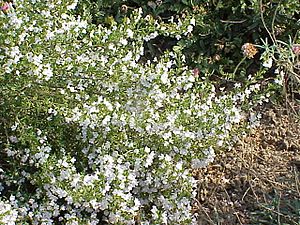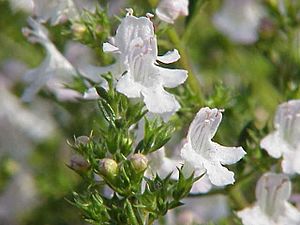Winter savory facts for kids
Quick facts for kids Winter savory |
|
|---|---|
 |
|
| Scientific classification | |
| Genus: |
Satureja
|
| Species: |
montana
|
| Synonyms | |
|
|
Winter savory (also called Satureja montana or mountain savory) is a type of plant. It is a herb that lives for many years. It keeps its leaves for most of the year. This plant belongs to the Lamiaceae family, which includes mint. It grows naturally in warm areas of southern Europe, around the Mediterranean Sea, and in Africa. Winter savory has dark green leaves. Its flowers bloom in summer and can be pale purple, pink, or white. Another similar plant, summer savory (Satureja hortensis), is an annual plant, meaning it lives for only one year.
Contents
About Winter Savory Plants
Winter savory plants usually grow to be about 10 to 40 centimeters (4 to 16 inches) tall. Their leaves are tough and dark green. They are shaped like ovals or needles. Each leaf is about 1 to 2 cm long and 5 mm wide.
The small flowers appear in summer, from July to October. They can be pale lavender, pink, or white. These flowers are smaller than those of summer savory. Winter savory contains a natural chemical called carvacrol.
History of Winter Savory
The famous scientist Carl Linnaeus first described this herb. He wrote about it in his book Species Plantarum in 1753. The second part of its scientific name, montana, means "from the mountains." This is why it is also known as 'mountain savory'.
Where Winter Savory Grows
Winter savory is originally from mild climate areas. These include parts of Europe, the Mediterranean region, and Africa.
It has also started growing naturally in Great Britain. You can often find it on old walls, dry hillsides, or rocky mountain slopes. It prefers soils that contain lime or are alkaline.
Growing and Using Winter Savory
People have used winter savory for a very long time. There is proof that the ancient Romans and Greeks used it about 2000 years ago.
How to Grow Winter Savory
Winter savory is easy to grow. It makes a nice border plant in a herb garden. It needs at least six hours of sunlight each day. The soil should drain water well. In places with mild winters, the plant rests during the cold months. It will grow new leaves on its bare stems in the spring. Do not cut the plant back, even if the stems look dead. It is a strong plant and grows in a low, bushy shape.
This plant can survive cold winters. It is hardy down to USDA Zone 4. You can grow new plants from cuttings taken from soft new growth.
Winter Savory as a Companion Plant
Winter savory is a good companion plant for other plants. For example, planting it near beans can help keep bean weevils away. It can also be planted with roses. This may help reduce mildew and aphids on the roses.
Types of Winter Savory
- S. montana 'Nana' is a smaller, dwarf type of winter savory.
- S. montana 'Prostrate White' is a small type with white flowers.
Winter Savory in Cooking
Winter savory is very popular in cooking. It tastes great with beans and meats. It goes especially well with lighter meats like chicken or turkey. You can use it in stuffing. It is also good in soups and sauces.
This herb has a strong flavor when it is raw. However, it loses much of its taste if cooked for a long time. You can add it to breadcrumbs to coat meats, such as trout.
Medicinal Uses of Winter Savory
People believe winter savory has several health benefits. It is thought to help clean wounds and have a pleasant smell. It may also help with digestion and clear breathing. Some people use a poultice (a soft, moist cloth with crushed leaves) of winter savory leaves on bee stings or insect bites. This plant is considered stronger than summer savory for these uses.
Traditional Remedies
When taken by mouth, winter savory is said to help with stomach cramps and gas. It has also been used to treat stomach flu, bladder problems, and feeling sick to your stomach. Some people use it for diarrhea, chest congestion, sore throats, and period problems. However, pregnant women should not use it.
Studies have shown that the oil from winter savory can stop the growth of certain fungi, like Candida albicans.
Other Uses
The plant is usually gathered in the summer when it is flowering. It can be used fresh or dried. The essential oil from winter savory is sometimes used in hair lotions. These lotions are for people who are starting to lose their hair. An ointment made from the plant can be rubbed on sore joints to help with pain.
A French herbalist named Maurice Messegue once called savory "the herb of happiness."
See also
 In Spanish: Satureja montana para niños
In Spanish: Satureja montana para niños



